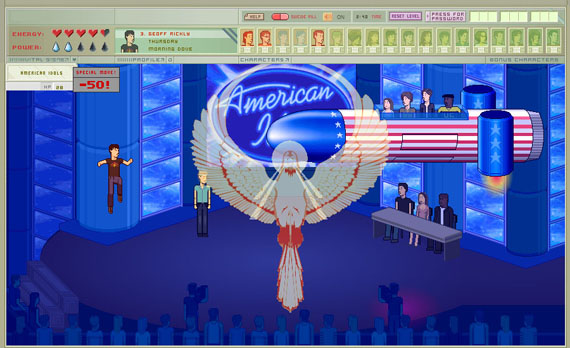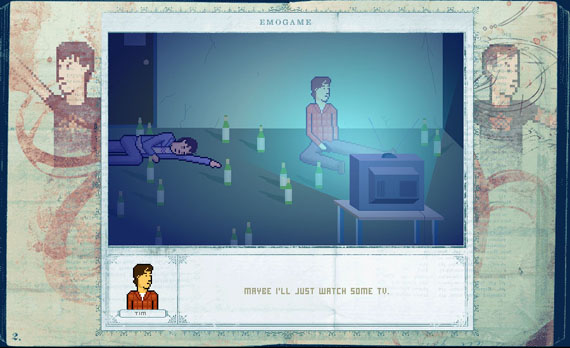For people of my age, for whom the internet started in the mid 90s, the perpetual newness of everything died when we started to notice the death of web crazes. We buried Strong Bad on top of Newgrounds, and realized the graveyard was several layers deep. Things don't stay online forever, it seems. Everything has a half-life.
Mostly these were inconsequential time wasters; things to do at the computer lab when the teacher was sick, or things to show your friends during lunch if you hung out in the classroom. The one that left any kind of mark on my personality going forward was the Flash-based platformer, EMOGAME. The name is an awkward dated piece of slang now, but in 2002, before there was "viral", this was a leading edge of coolness and satire in my world.
In the time of 2002, post-dotcom bubble hype and pre-social media, the genre culture of indie music seemed to be blossoming. It was always there, of course, but the culture of it didn't begin to turn into the commercial force it is today until the development of its institutions. From my perspective, a few things happened: Pitchfork moved to Chicago and became the fully stocked news & reviews site we know today. The scene had become worth talking about, as seen in the 2003 book "Nothing Feels Good" by Andy Greenwald. Then, acts that were on the periphery of the culture started to bleed into the MTV mainstream.
These acts weren't genre-kings of indie, but they didn't fit into the nu-metal, rap-rock or alternative mold MTV & KROQ had built. So we started to learn about emo, and its familial line toward indie. This tangential relation and mega success did something important: it took the cultural conversation about indie music above ground. In order to ward off posers, the chat rooms and message boards I frequented had to define bands as within or without. The Jimmy Eat World fans were starting to learn about Pavement. Half of us lured in by the casual pop were given the chance to go deeper. For me, with my brain at a soft, impressionable state known as High School, this cultural conversation was a learning experience.
The conversation took place all over the big music internet of the time: Buddyhead, Pitchfork, and a little personal project called EMOGAME by one Jason Oda. It was a retro 8-bit style platformer where you controlled an all-star cast of emotional dudes like Chris Carraba and Cedric Bixler to save The Get Up Kids while slaying the likes of Creed, Enrique Iglesias and the cast of Friends. In their words, it took the day's hip young musicians on a tour to defeat "idol worship of vapid actors and corporate musical entities." The appeal for me was three-fold: It was a rare extensive flash game (it took hours to beat and used save slots), its humor was chock full of pop culture and crude violence like South Park, and its art style was hip several times over.

Today, the game is unquestionably shitty: the physics are inexcusable, there isn't much variety to the gameplay, and all the characters are essentially the same except in their projectile and special move. (Conor Oberst summoned exploding mirrors.) The art, though, still has its appeal. The sprites themselves were basic, almost like Atari figures with more colors, but it was contrasted with meticulous geometric pixel art that was occasionally detailed. I was heavily into the "culture" of Flash games back then, since I weas riding a wave of enthusiasm sparked by a year of animation electives in school, and I don't think anyone was making anything like EMOGAME back then.
The popularity eventually evolved into EMOGAME 1.5, subtitled "Alkaline Trio vs. Hell" which was a fun, shorter distraction that came just in time for my devotion to their album GOOD MOURNING. The big thing was the official sequel, EMOGAME 2, which was blown up in every way: longer, more characters (Jenny Lewis! Gretta Cohen! A guy from The Juliana Theory!) and a whole lot harder. And all the while, it was pretty.
The only thing I really remember is the ending. A black void begins to eat away the world, breaking apart even the window that framed the game, in a pretty cool visual device. Your indie/emo heroes escape on the back of Falkor from The Neverending Story, and eventually it's revealed that you, the player, are part of the problem. You are admonished for spending so much time on worthless, unproductive tripe like this game and believing whatever it is it told you to believe. It lured you with its hate for Steven Tyler and American Idol, and then it told you that you should make up your own damn mind. The ending featured a remade, better world, where people threw their Xboxes out of windows and got up off the couch.
I remember reading reactions. To a lot of us, it was a stupid, annoying ending and today there's still an element of eye-rolling to its soapbox. But it was appropriate for a 16 year old me at the time. I was annoyed, feeling betrayed, and unable to stop mulling over its lecture. That's a good reaction to get in hindsight, but I couldn't figure out how he was going to get people to give him money after he had just talked down to his whole audience.
Still, Jason Oda rolled on and I kept checking in to see what he was working on. In 2004 he put out an anti-George W. Bush game ("The Anti-Bush Game") with the same engine and style, except you got to control pop culture icons like Hulk Hogan and He-Man. It featured the GOP pissing on you from above as an explanation of trickle-down economics, a joke I would see repeated 8 years later on The Daily Show.
Then he started getting professional commissions by actual bands. I remember a launching game called Dropkick The Faint, but I couldn't figure out if it was pro- or anti-The Faint. He made a great Straylight Run website that combined the vintage ornate art style we now see on Shepherd Fairey t-shirts with his usual intricate pixel art. These days, he seems to have made a full blown career out of his talent, creating Flash & Facebook games for big corporations with his retro references and distinct imagery. His company used to be called Starving Eyes, a reference to Cursive & Bright Eyes, but I guess like all of us he left the emo aesthetic behind.
I hadn't thought about the game in years. I don't know what caused it to crop back up while I was driving on my hour long commute 10 years later. It occurred to me those couple of years, when it enjoyed viral success, were important & forgotten pieces in the development of my taste. It's weird to think, as internet culture accelerates faster and faster, that these things that were big to some people will be forgotten completely eventually. It's not like in the old monoculture where we all have similar points of reference, whether it's The Honeymooners or Ninja Turtles. We're going to be sharing less and less cultural touchstones. We will be one of only a few hundred people to have loved something, and if we all forget, it will be gone forever. I may never run into someone that played EMOGAME ever, and it will go into the abyss with Albino Blacksheep and guestbooks.

